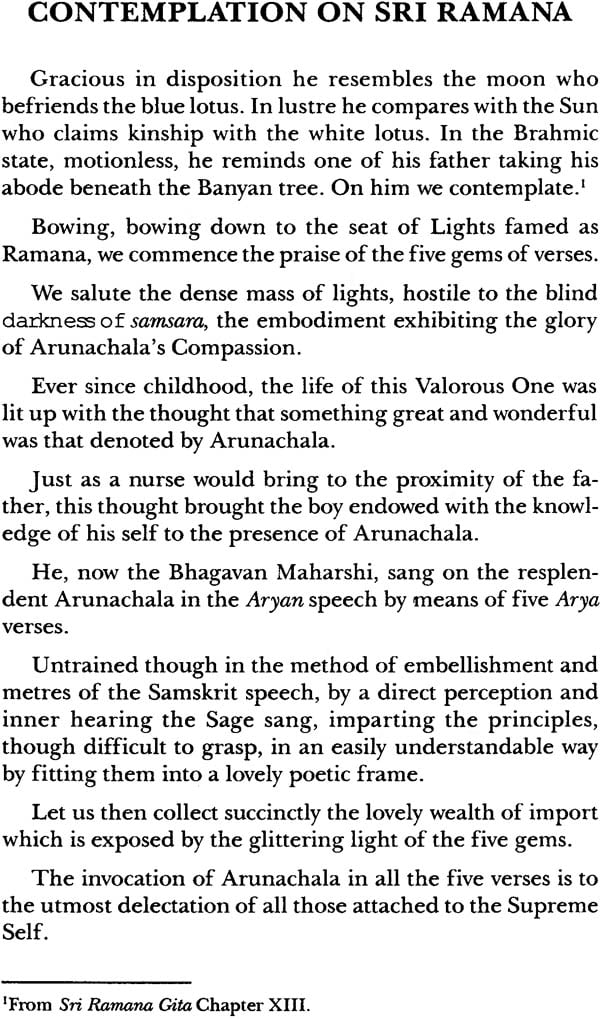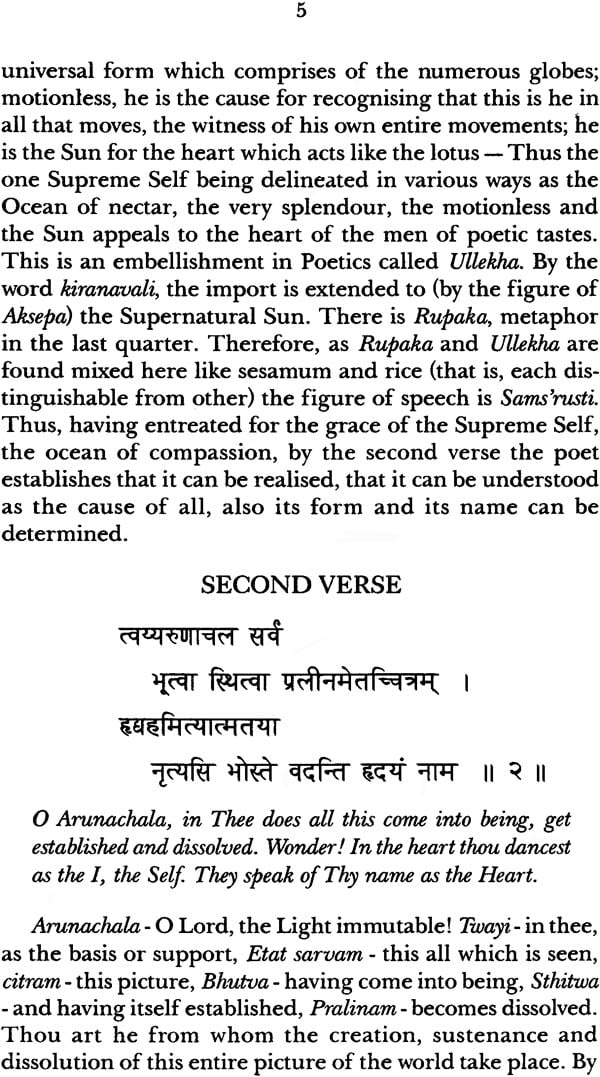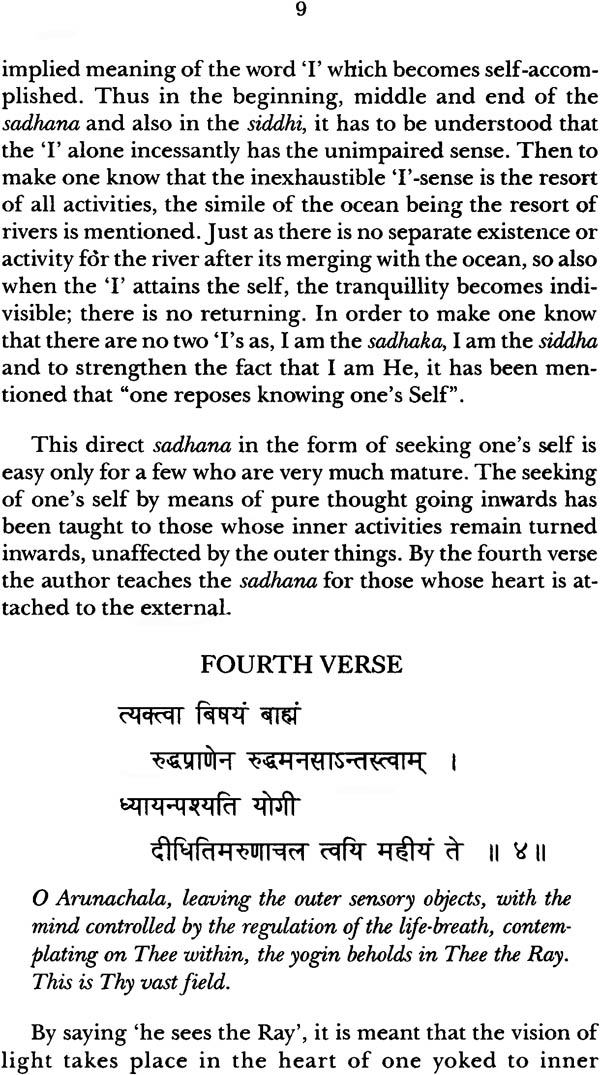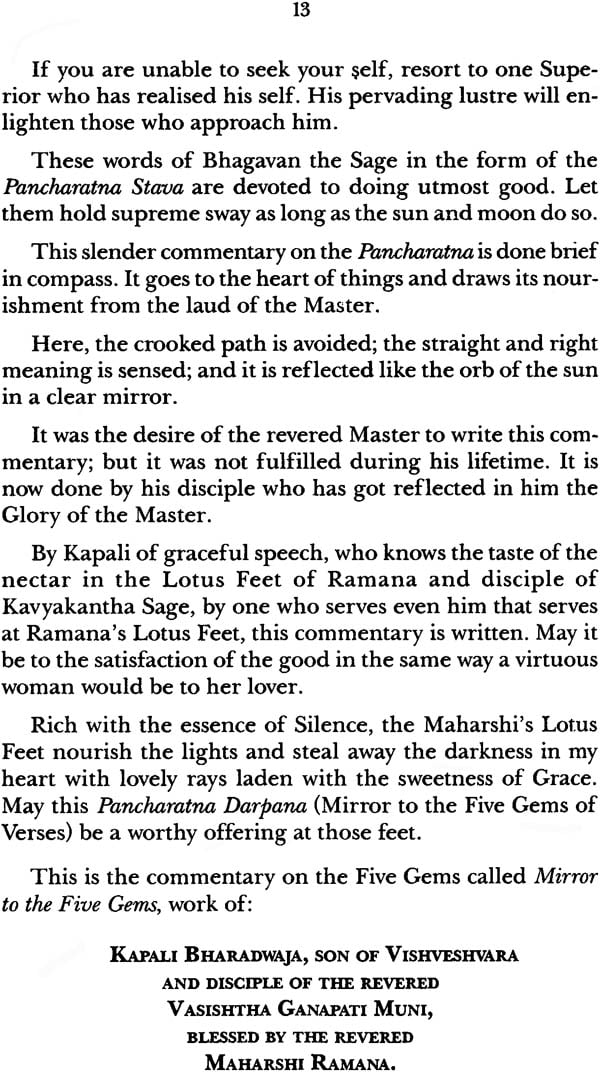
The Cardinal Teaching of The Maharshi (Sri Arunachala Pancharatna Darpanam)
Book Specification
| Item Code: | NAF609 |
| Author: | Bhagavan Sri Ramana Maharshi |
| Publisher: | Sri Ramanasramam, Tamil Nadu |
| Language: | English |
| Edition: | 2016 |
| ISBN: | 9788188018543 |
| Pages: | 20 |
| Cover: | Paperback |
| Other Details | 8.5 Inch x 5.5 Inch |
| Weight | 40 gm |
Book Description
Kavyakantha Ganapati Muni was of the foremost devotees of Bhagavan Ramana, a great Sanskrit scholar and a tapasvin of a very high order. It was he who gave to the sage the name Bhagavan Sri Ramana Maharshi. Ganapati Muni was affectionately addressed as Nayana by Sri Bhagavan.
One day in the year 1917, while Sri Bhagavan was living at Skandashram, Ganapati Muni approached him and requested him to compose a poem in Sanskrit in the arya metre. The Maharshi pleaded that he knew very little Sanskrit, much less about its meters. The Muni then explained the rules of the arya metre and repeated his request.
Later Sri Bhagavan presented to the astonished scholar five verses in beautiful Sanskrit set perfectly to the arya meter. These verses present in a succinct manner the highest teachings of Sri Bhagavan. Morover they are in praise of Sri Arunachala.
These five verses were later translated into Tamil in verse form by Sri Bhagavan himself and constitute the last of the five hymns to Arunachala.
This scholarly commentary on the Five Verses has been written by Sri Kapali Sastri, an early devotee of the Maharshi and a disciple of Ganapati Muni.
A sthithaprajna, ever settled in divine consciousness, though he was, Bhagavan was intensely human in his dealings. He always showed an understanding which made the smallest feel great in his presence. He responded to all approaches of genuine devotion and love with a compassion that was overwhelming. It was so he came to give to the world his celebrated Hymn to Arunachala.
Nayana known as Vasishtha Ganapati Muni, his premier disciple, once asked him to compose some verses in Sanskrit. Bhagavan demurred saying he did not know the language for that purpose. Nayana briefly explained the construction for the arya metre. The Five Gems on Arunachala were the result. Obviously Bhagavan did not compose them; they welled out of his inner hearing in the manner of the Rirs of the Seers of the Vedas. The mater was perfect arya, the subject was an epitome of his Teaching of the direct Path to the self, the from was a laudation of a Arunachala conceived as the Self of All.
In the first verse the sage invokes the compassion and Grace of the supreme for it is only by Grace that one is awakened to the necessity of spiritual Quest and by Grace is one enabled to pursue it to a successful culmination.
In the second, the Self – symbolised by Arunachala – is described as the sole Reality, the heart of things, the one Truth at the core of all existence.
In the third and the fourth is indicated the sadhana, the inner process by which this Reality is realized within one self. Withdrawal from the outward senses and a sustained in-going of the mind with the aid of breath, culminating in the revelation of the Light of the Self, brings an utter tranquility in the being.
In the fifth and the last verse, he celebrates the glory of Arunachala, the supreme Self which comes to be perceived everywhere by the favoured of the Grace. Dedicated to the Self, devoted exclusively to the Self, Seeing only the Self, he is immersed in the Felicity that is the self.
Nayana was ecstatic over this unexpected bounty of the Grace of Ramana. He wanted to write a commentary on these precious gems of verses but somehow it was not to be. His gifted disciple Sri Kaplali Sastriar has fulfilled that wish in his commentary entitled Sri Arunachala Pancharatna Darpanam-a mirror faithfully reflecting the profound contents of the hymnal treasure.
Both the text and the commentary being in Sanskrit, this significant work has so far remained outside the reach of all who are not conversant with that language. The present accurate rendering in English by Sri S. Shankaranarayanan, a versatile scholar and devoted disciple of Sastriar, meets this need in an ample measure.









